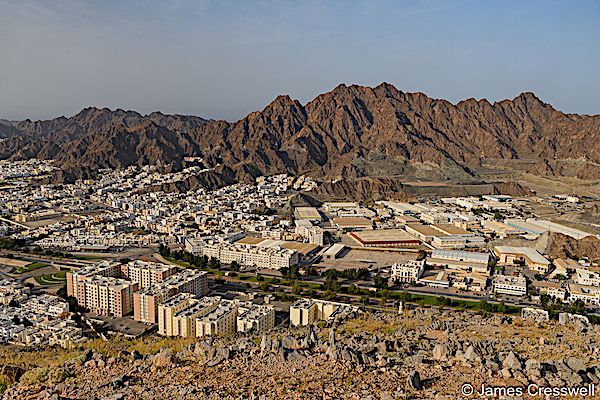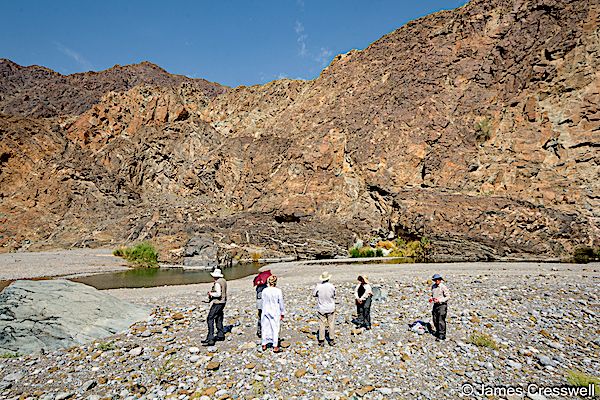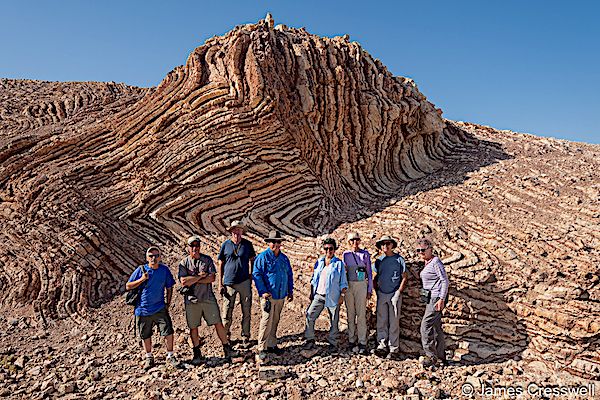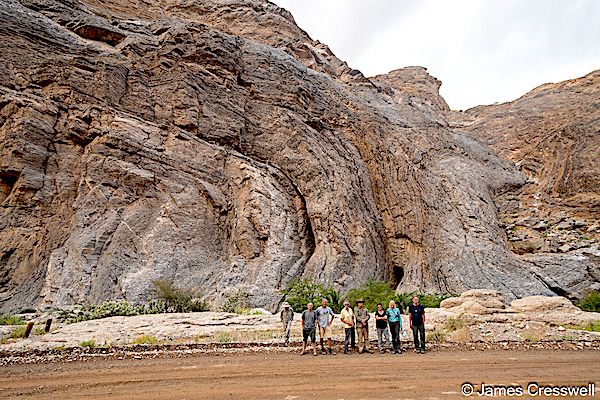The geology of Oman - James Cresswell of GeoWorld Travel
The Geology of Oman by James Cresswell based on one of James’ tours.
James gave a really interesting talk about the fascinating geology to be found in Oman. The talk concentrated on the geology of the northern part of the country with the tour commencing at Muscat, travelling north to Sohar, then to Nizwa, on to Sharqiya Sands (Wahiba Sands), and then over to the coast at Sur before returning to Muscat.

A view over the capital city of Muscat. In the background, the mountains are made of peridotite which was once part of the mantle, whilst the city sits on the Kabir Fault, which was once a former subduction zone.photo by James Cresswell
Oman sits on the north-eastern portion of the Arabian plate at the convergence zone between the Arabian and Eurasian plates. At this point the oceanic crust of the Oman Sea is subducting under the lithosphere of the Eurasian Plate.To the north the Arabian plate is rifting away from the African plate at a divergent margin.
The main focus of the geo-tour was the Semail Ophiolite which is the world’s largest and best preserved ophiolite. The ophiolite is a vast thrust sheet of Cretaceous ocean crust and upper mantle emplaced onto the Arabian continental margin during late Cretaceous times. It is 500km long 50-150km wide and 15 km thick. New findings suggest that it was formed above an active NE dipping subduction zone
James then went on to describe the structure of the ophiolite along with the locations at which the various components may be found.
- The metamorphic sole amphiboles beneath the Semail thrust plane that carries the entire ophiolite above.
The rocks of the metamorphic sole were visited at Wadi Hawasina.The Metamorphic sole is suggested to have been formed as material moving down the subduction zone underwent metamorphism and finally being obducted onto the surface.The degree of metamorphism producing amphibolite and greenshist.
Beneath the metamorphic sole of the ophiolite is a series of thrust sheets (nappes) including the Haybi Complex comprising distal sedimentary and volcanic rocks, Late Triassic alkali basalt and limestone seamounts and mélanges. Below the Haybi Complex is the Hawasina complex, a series of 4–7 thrust sheets of basin to shelf slope sediments.
- The mantle sequence peridotites and the Moho Transition Zone with dark wehrlites and pale coloured gabbros intruding harzburgites.
These rocks including pale coloured dunites and brown harzburgites, can be found at Wadi al Abyad. Mantle,rock (peridotite) can be found at the base of a cliff with a clear line separating them from layered gabbros above. The clear line separating the two is the Moho ( boundary between the mantle and the earth’s crust). At Wadi Hawasina mantle peridotites of the Semail ophiolite may also be found along with heavily folded marine sediments of the Hawasina nappe. Peridotites of the Semail Ophiolite may also be found around Muscat.

The Moho at Wadi al Abyad. This is the best place in the world to see the Moho (The Mohorovičić discontinuity) – the boundary between the earth’s crust and mantle.Photo by James Cresswell
-
Layered lower crustal gabbros inter-banded with dark coloured mantle peridotites could be seen at Wadi al Abyad. The layering is due to differential crystallisation in the magma chamber
-
At Sohar sheeted dykes which form part of the classic ophiolite sequence can be seen. The complex consists of swarms of basaltic dykes which are the feeder dykes for the overlying pillow basalts.
Also at Sohar there is a fossilised Black Smoker that formed on the ocean floor as part of the ophiolite complex. This was a vent for superheated water loaded with dissolved sulphides and a high concentration of copper, zinc and manganese. This is a now a large ore body that is likely to be exploited. It is actually placed within the Geotimes Unit but is partially covered by the Tholeiitic Unit. Close to this site is another site known as the Umber sediments which are rich in iron and manganese and were formed in association with the Black Smoker. The metal enrichment is due to precipitants from the Black Smoker settling on the mud of the ocean floor. They are un-metamorphosed and cover the pillow basalts of the ophiolite.
At a second site close to Al Ghizayn is a fossilised White Smoker. Similar to the Black Smoker but has much lower temperatures and therefore less metal enrichment but contains lots of opaline silicate. -
The Geotimes unit lower V1 pillow lavas at Wadi Jizzi are considered to be the best outcrop of this kind in the world.The basalts were erupted onto the seabed and formed the pillow structures as they were cooled by the surrounding sea water. They are fed by dykes rising from the sheeted dyke complex. The pillows have a glassy outer skin ( basaltic glass). These particular pillow basalts are elongate in shape suggesting they were oozing outwards and downwards onto a slope and have a diameter of 0.5-1m.
Geochemical analysis of immobile trace elements like titanium have shown that volcanics found in hotspots are geochemically very distinct from those erupted at mid-ocean ridges and both of these are very distinct from andesitic lavas found in island arcs. Using this technique it was shown that the lavas of the Semail ophiolite were erupted in two different phases. The Geotimes unit was erupted at a spreading ridge but the later lavas included a rock known as boninite which is always found above subduction zones. Therefore it is suggested that to begin with the Geotimes basalt would have formed due to spreading but as subduction proceeded and increased in depth the chemistry of the melt changed producing the different lavas as seen. These other lavas have been mapped as the Tholeiitic Alley and Boninitic Alley Pillow lavas.
The tour not only focused on the ophiolite but explored many other aspects of the wonderful geology present. One of these sites, near Sur,is named "The Mother of all Outcrops”. Here, folded and faulted, red radiolarian chert is interbedded with white porcellanite ( an impure chert containing clay and carbonates). These sediments were deposited in water 4,000-4,500 metres deep, and were thrust onto Arabia as part of the Batain Nappe (along with Oman’s other ophiolite, the Masirah Ophiolite), 15-20 ma after the emplacement of the main Semail Ophiolite.

The GeoWorld Travel group at the so-called ‘Mother of All Outcrops’ which are tightly-folded, alternating layers of radiolarian chert and porcellanite. These were folded with the obduction of Oman’s other ophiolite, the Masirah Ophiolite. photo by James Cresswell
Another site near to Sur is of Precambrian crystalline basement (800-1,000 million years old). Here there are granites that formed as terranes, were accreted together and then cut by huge gabbro dykes that were intruded as the basement went through a later period of extension. All these rocks are themselves intruded by granitic pegmatite dykes
Another fascinating geological structure is the Wadi al Mayh mega sheath fold. It is the best exposed sheath fold in the world and is 15km long. The rocks record progressive burial and exhumation of the thinned and stretched leading margin of the Arabian continental crust down a subduction zone to depths of up to 80-100km.

A large isoclinal fold, Part of the mega sheath fold at Wadi al Mayh photo by James Cresswell
In addition to all the above, the tour covered areas related to periods of “Snowball Earth” at Wadi Haslan; a viewpoint of Jebel Shams, Oman’s highest peak (3,028m) and of Wadi al Nakhr, which is also known as the “Grand Canyon of Arabia” and a visit to Wadi Shab, a magnificent canyon cut into Eocene limestone, which is considered by many to be Oman’s most beautiful Wadi. There were also some archaeological sites that the tour visited for example south eastern Arabia's most important Neolithic rock engravings, at Hasat Bin Salt also known as Coleman’s Rock and “The Aflaj Irrigation System of Oman”. This irrigation system is up to 4,500 years old and is seen as one of the driving forces behind the formation of Oman as a nation as it provided the reason for nomadic societies to settle down. Both of these are World heritage sites.
This was a super talk about a country with fascinating geology.
If you would like to know about James Creswell’s tours his website is as follows:
[http://www.geoworldtravel.com]
If you would like to know more about the geology of Oman then the following book will be of interest:
Field Guide to the Geology of Northeastern Oman edited by Gosta Hoffman, Martin Meschede, Anne Zack and Mohammed Al Kindi. ISBN:978-3-443-15099-0